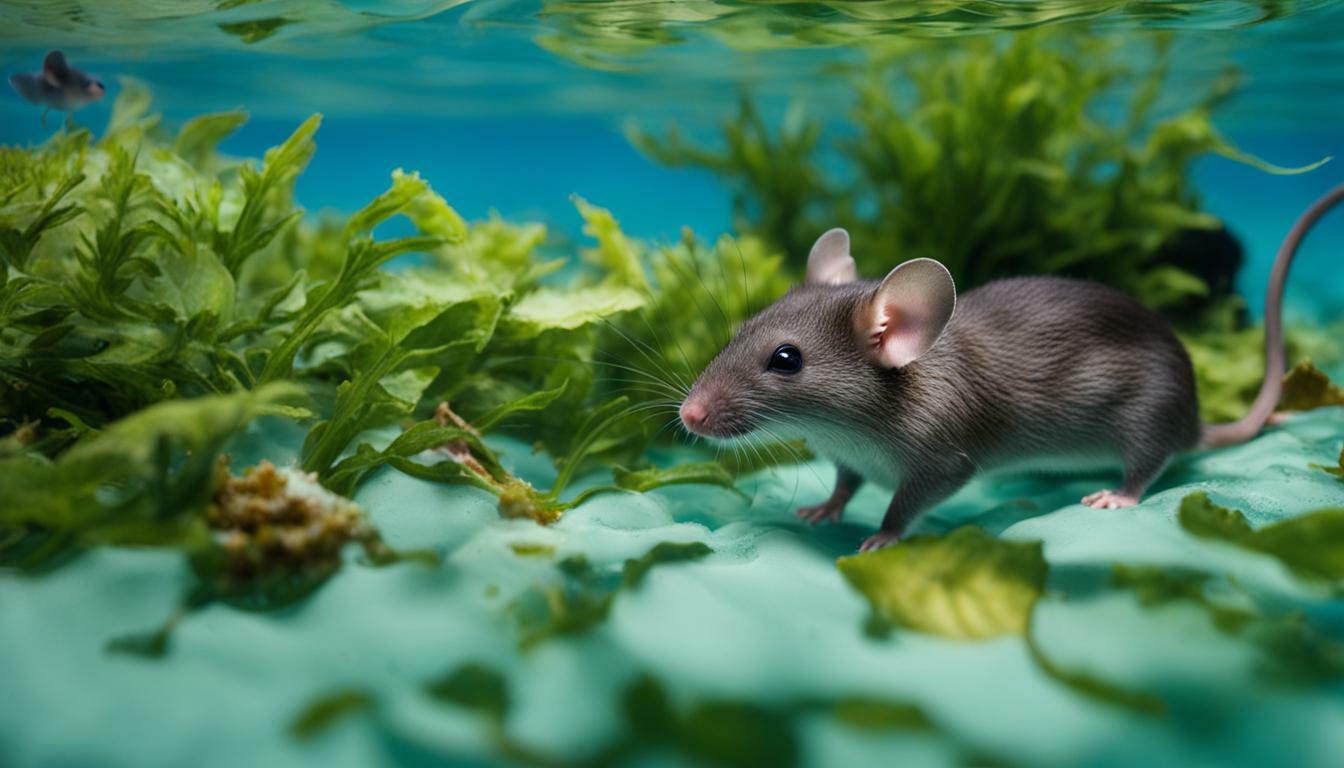Mice are surprisingly capable swimmers, but is swimming their preferred mode of travel? Let’s explore the swimming abilities of mice and their relationship with water.
- Mice can swim and tread water for up to three days.
- They can hold their breath underwater for up to three minutes.
- Swimming is not the preferred choice for mice, and they will typically choose dry land over water if given the option.
- Swimming exposes mice to predators, making it a vulnerable position for them.
- Mice can be deterred from pools by keeping the pool area clean and free of debris.
The Swimming Abilities of Mice
Mice possess fascinating swimming abilities and can survive in water for a surprising amount of time. While it is not their preferred method of travel, mice have the capability to swim and tread water for up to three days. They also possess the ability to hold their breath underwater for about three minutes, allowing them to navigate through aquatic environments.
When faced with water, mice exhibit interesting behaviors. They will typically choose dry land over water if given the option, as swimming puts them in a vulnerable position and exposes them to potential predators. However, if the need arises, mice can skillfully maneuver in water using a range of techniques.
The Techniques Mice Use to Swim
Mice employ various techniques to swim effectively. Their movements are characterized by rapid paddling of their limbs and synchronized tail motions. These coordinated actions allow them to propel themselves through the water, demonstrating their agility and adaptability. Additionally, mice have remarkable body adaptations for swimming, with their sleek fur and streamlined bodies reducing water resistance.
It is interesting to note that while mice have the ability to swim, they do not possess natural buoyancy like some other aquatic animals. This means that they cannot float effortlessly on the water’s surface. Instead, mice must continuously paddle their limbs to stay afloat and avoid submerging completely. This requirement for constant movement may explain why they prefer dry land whenever possible.
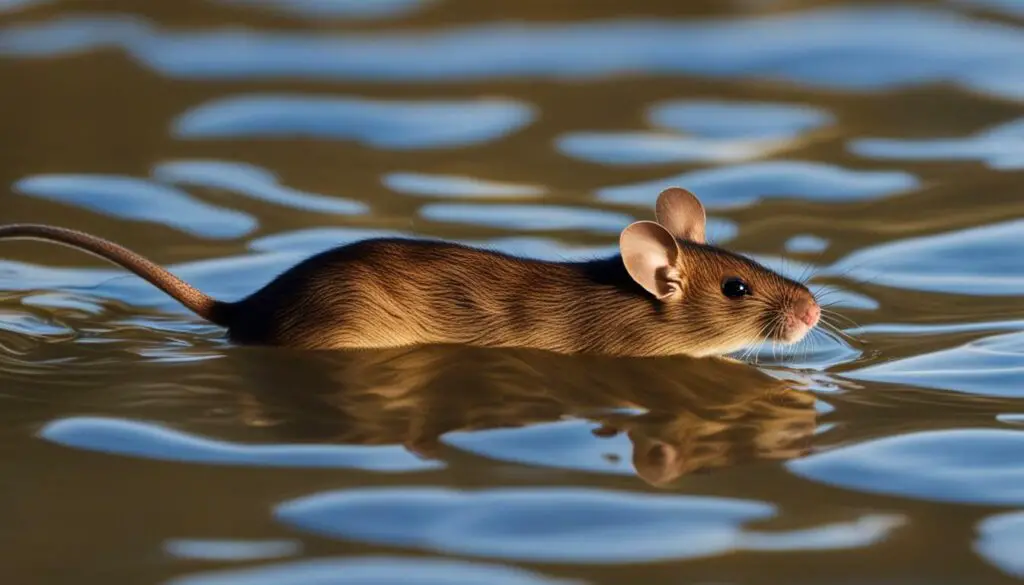
The Importance of Deterrence and Prevention
Given their vulnerability in water and the potential risks associated with swimming, it is crucial to take measures to deter mice from entering pools and other water sources. By keeping the pool area clean and free of debris, mice are less likely to be attracted to the water. Additionally, maintaining the surrounding landscape and removing potential hiding places can discourage mice from venturing near the pool.
Using scent discs or mouse baffles as deterrents can also be effective in keeping mice away. These scented items emit odors that mice find unpleasant, deterring them from approaching the water. Furthermore, installing pool fences or barriers provides a physical barrier that prevents mice from accessing pools, reducing the risk of them entering the water.
By implementing these preventive measures, you can create an environment that discourages mice from swimming and protects them from potential harm. It is essential to prioritize the safety and well-being of both mice and humans when it comes to water-related situations.
| Summary: |
|---|
| Mice possess fascinating swimming abilities and can survive in water for up to three days. |
| They utilize techniques such as rapid paddling of limbs and synchronized tail motions to swim effectively. |
| Mice do not possess natural buoyancy and must continuously paddle to stay afloat and avoid submerging. |
| Preventive measures such as cleanliness, landscaping, scent discs, and pool barriers can deter mice from entering pools and water sources. |
Mouse Swimming Techniques
Mice employ unique swimming techniques to traverse through water. Despite not being their preferred mode of travel, they do possess the ability to swim and even tread water for up to three days. When faced with an aquatic environment, mice demonstrate remarkable adaptability and resourcefulness.
One of the key techniques that mice utilize while swimming is their synchronized paddling motion. They use their forelimbs, moving them in an alternating fashion, to propel themselves forward. This coordinated movement allows them to navigate through the water with relative ease. Additionally, mice employ their tails as rudders, using them to steer and maintain stability.
Another important adaptation mice employ while swimming is their ability to hold their breath for extended periods. They can stay submerged underwater for up to three minutes, enabling them to explore their surroundings and access food sources that may be situated underwater.
| Mouse Swimming Techniques |
|---|
| Synchronized paddling motion using forelimbs |
| Use of tail as a rudder for steering |
| Ability to hold breath underwater for up to three minutes |
Although mice can swim adeptly, it is important to note that swimming exposes them to increased vulnerability. As they venture into the water, they become more susceptible to predation. Due to this risk, mice typically opt for dry land whenever possible and only resort to swimming when necessary.
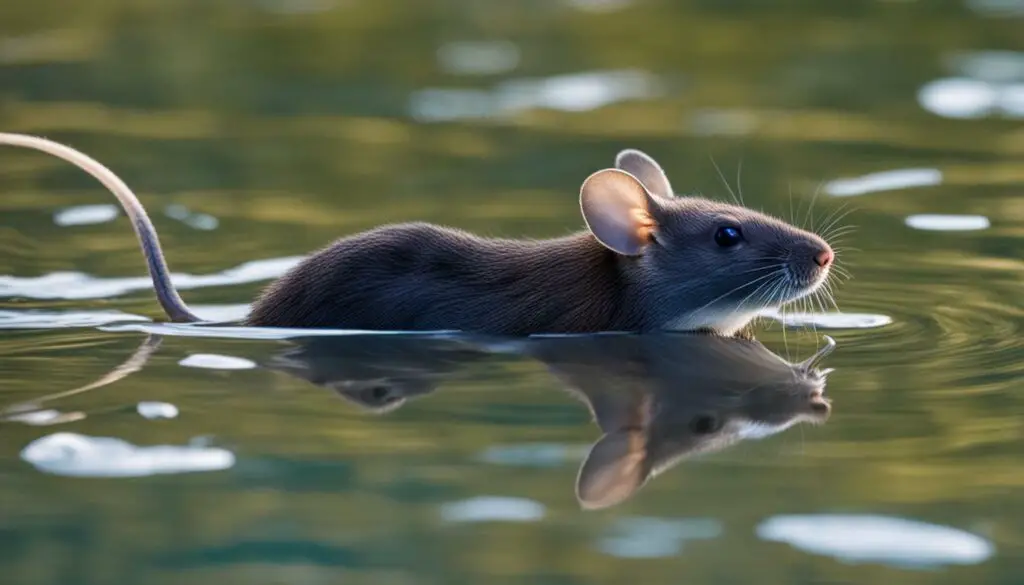
To deter mice from entering pools and reduce the risk of encounters, several preventive measures can be taken. Keeping the pool area clean and free of debris is crucial, as it discourages mice from approaching the water source. Maintaining well-groomed landscaping around the pool helps eliminate potential hiding places. Scent discs or mouse baffles can be strategically placed to deter mice from venturing near the pool. Additionally, installing pool fences or barriers acts as a physical deterrent, preventing mice from accessing the water.
Can Mice Float in Water?
Find out if mice have the ability to float effortlessly in water. While mice are capable of swimming, it is important to note that floating is not their strong suit. Mice possess natural buoyancy, which allows them to stay afloat for a brief period of time, but they do not float effortlessly like some other animals. Instead, they rely on their swimming abilities to stay above water.
When mice are in water, they exhibit certain survival skills to prevent drowning. They paddle their legs and use their tails to help them navigate through the water. This movement, along with their small size, allows them to stay afloat for a limited time. However, due to their small lung capacity, mice cannot hold their breath for an extended period, and eventually, they will need to resurface for air.
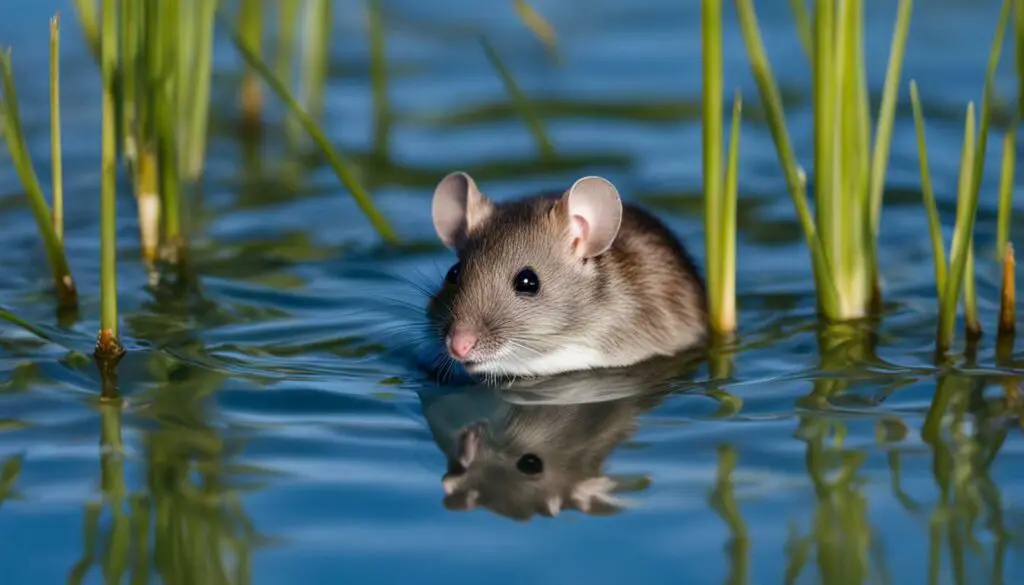
To discourage mice from entering pools and water sources, it is crucial to maintain a clean and debris-free environment. Mice are attracted to areas with food sources and hiding places, so by keeping the pool area tidy, you can make it less appealing for them. Additionally, landscaping modifications can help remove potential hiding spots, reducing the likelihood of mice approaching the water.
| Skill | Description |
|---|---|
| Paddling | Mice paddle their legs to stay afloat and move through the water. |
| Tail assistance | They use their tails as rudders to steer and maintain balance while swimming. |
| Breath-holding | Mice can hold their breath underwater for up to three minutes. |
| Vulnerability | Swimming puts mice in a vulnerable position, making them more exposed to predators. |
Preventing Mice from Entering Pools
To deter mice from entering pools, various measures can be taken. Scent discs or mouse baffles can be used as deterrents, as mice are often repelled by certain scents. Additionally, installing pool fences or barriers can physically prevent mice from accessing the water. These proactive steps can significantly reduce the likelihood of mice entering pool areas and ensure a more enjoyable swimming experience for humans.
The Drowning Risk for Mice
Discover whether mice face a risk of drowning when exposed to water. While mice possess the ability to swim, they typically do not seek out bodies of water willingly. Swimming is not their preferred form of travel, and they will choose dry land over water if given the option. However, in certain situations, mice may find themselves in water and face the risk of drowning.
Mice are capable of treading water for up to three days, showcasing their impressive aquatic survival skills. They can also hold their breath underwater for up to three minutes, allowing them to navigate short distances. Despite these abilities, it is important to note that swimming puts mice in a vulnerable position, making them easier targets for predators.
To prevent mice from entering pools and potentially drowning, there are several practical steps you can take. Keeping the pool area clean and free of debris is crucial, as mice are attracted to food and shelter. Regularly maintain the landscaping around the pool to remove potential hiding places for mice. Using scent discs or mouse baffles can also serve as effective deterrents, as mice are sensitive to strong smells. Additionally, installing pool fences or barriers will physically prevent mice from accessing the pool, reducing the risk of drowning.
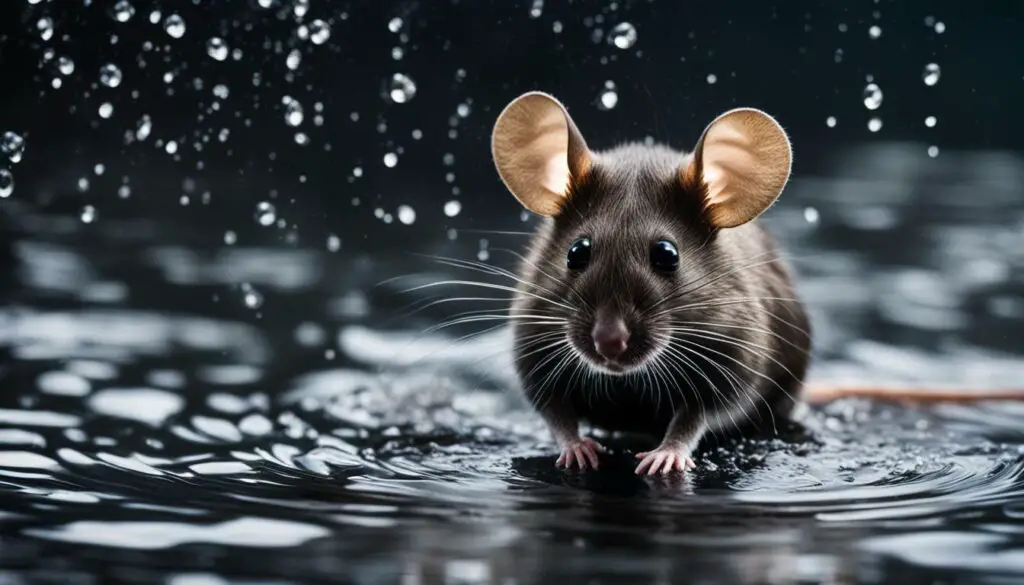 In conclusion, although mice can swim, they are not natural water dwellers and can drown when exposed to water. Their preference for dry land and vulnerability in aquatic environments highlight the importance of taking preventive measures to keep them away from pools. By maintaining cleanliness, modifying landscaping, and implementing physical barriers, you can effectively deter mice from accessing water sources and reduce the risk of drowning.
In conclusion, although mice can swim, they are not natural water dwellers and can drown when exposed to water. Their preference for dry land and vulnerability in aquatic environments highlight the importance of taking preventive measures to keep them away from pools. By maintaining cleanliness, modifying landscaping, and implementing physical barriers, you can effectively deter mice from accessing water sources and reduce the risk of drowning.
Mouse Habitat and Water Behavior
Learn how mice interact with their habitats and navigate water-rich environments. Mice are incredibly adaptable creatures and can be found in a wide range of habitats, including forests, fields, and even urban areas. When it comes to water, mice display interesting behaviors and adaptations.
In their natural habitats, mice encounter various water sources such as rivers, ponds, and streams. While they have the ability to swim, mice prefer to stay on dry land whenever possible. Swimming is not their preferred mode of travel, and they will only resort to it when necessary.
When mice do find themselves in water, they rely on their natural instincts to navigate and survive. They use a combination of doggy paddling and their long tails to propel themselves through the water. Their bodies are streamlined, allowing them to move efficiently. However, it’s important to note that prolonged exposure to water can be dangerous for mice, as it makes them more vulnerable to predators.
Mouse Adaptations for Water Survival
| Adaptation | Description |
|---|---|
| Water-Repellent Fur | Mice have fur that is naturally water-resistant, helping to keep them dry and warm when in water. |
| Swimming Techniques | Mice use a combination of paddling their legs and using their tails to maneuver through water. |
| Diving Abilities | In some cases, mice are capable of diving underwater for a short period when escaping from danger. |
To discourage mice from venturing into water-rich areas, it’s important to take preventive measures. Keep the pool area clean and free of debris as mice are attracted to food sources. Regular landscaping maintenance can remove potential hiding places and minimize their access to pools or bodies of water near your property. Using scent discs or mouse baffles can also be effective deterrents. Additionally, installing pool fences or barriers can prevent mice from entering the pool area altogether.
By understanding how mice interact with their habitats and their behavior in water-rich environments, you can take the necessary steps to prevent mice from becoming a nuisance around your property.
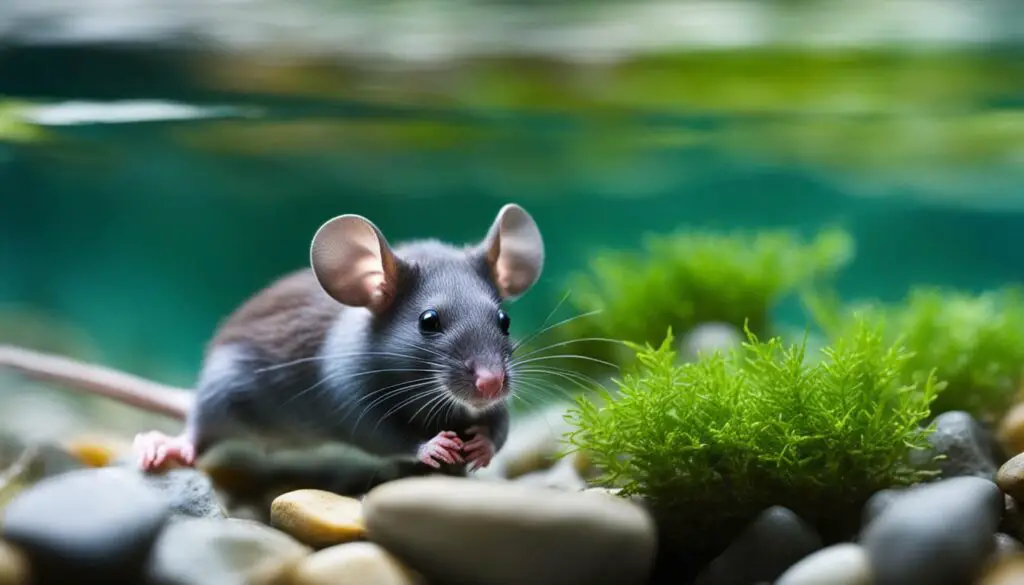
Find out how to keep mice away from pools and ensure a pest-free swimming experience. While mice have the ability to swim, they do not typically enjoy being in the water and will choose dry land whenever possible. However, if a mouse finds its way into your pool, it can pose a nuisance and potentially contaminate the water. To prevent mice from entering your pool area, there are several steps you can take.
First and foremost, it is important to keep the pool area clean and free of debris. Mice are attracted to food sources, so make sure to remove any food remnants or spills in the pool area. Additionally, regularly empty and clean any outdoor trash cans to eliminate potential food sources for mice.
Another effective method to deter mice is by maintaining the landscaping around your pool. Trim any overgrown bushes or shrubs near the pool, as mice may use them as hiding places or pathways. By keeping the surroundings well-maintained, you reduce the chances of mice approaching the pool area in the first place.
There are also specific mouse deterrents that can be used to keep mice away from your pool. Scented discs or mouse baffles, available at most hardware or pest control stores, can be strategically placed around the pool area to repel mice. The strong scent emitted by these deterrents is usually unpleasant for mice and will discourage them from entering the pool area.
| Deterrent | Effectiveness |
|---|---|
| Scented discs | High |
| Mouse baffles | Moderate |
Lastly, consider installing pool fences or barriers to further prevent mice from accessing the pool. These physical barriers can be an effective way to keep mice out, especially if your pool is located in an area with a high mouse population. Consult with a professional to determine the best type of fence or barrier for your specific pool setup.
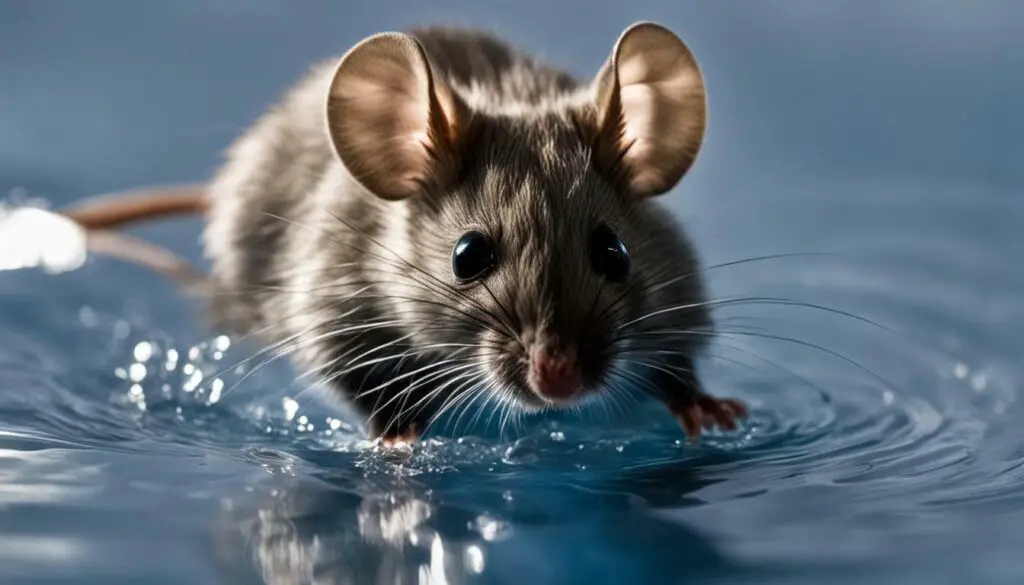
By following these preventative measures, you can minimize the chances of mice entering your pool area and ensure a pest-free swimming experience. Remember to keep the pool area clean, maintain the landscaping, use mouse deterrents, and consider installing pool fences or barriers. By taking these steps, you can enjoy your pool without worrying about unwelcome furry visitors!
Landscaping and Mouse Deterrents
Discover effective landscaping strategies and mouse deterrents to discourage mice from entering water sources. When it comes to keeping mice away from pools and other water areas, modifying the surroundings can make a significant difference. By implementing the right landscaping techniques and using mouse deterrents, you can create an environment that mice find unappealing.
Start by removing any potential hiding places around the pool area. Trim overgrown bushes and trees, and clear away debris that may provide mice with shelter. Mice are more likely to stay away from spaces that are open and well-maintained.
Additionally, consider using scent discs or mouse baffles. These deterrents emit odors that are unpleasant to mice, keeping them at bay. Place them strategically around the pool area to create a deterrent barrier. These simple and natural solutions can help discourage mice from approaching water sources.
| Landscaping Strategies and Mouse Deterrents | Benefits |
|---|---|
| Clearing away debris and maintaining a clean pool area | Reduces potential hiding places for mice and makes the area less inviting |
| Trimming overgrown bushes and trees | Creates an open and well-maintained space that mice are less likely to inhabit |
| Using scent discs or mouse baffles | Emits odors that mice find unpleasant, creating a deterrent barrier |
By implementing these landscaping strategies and using mouse deterrents, you can minimize the chances of mice entering water sources. Keep in mind that prevention is key, as it is often easier to deter mice than to remove them once they have established a presence. By creating an environment that is uninviting to mice, you can enjoy your pool and water areas without the unwanted company of these furry creatures.
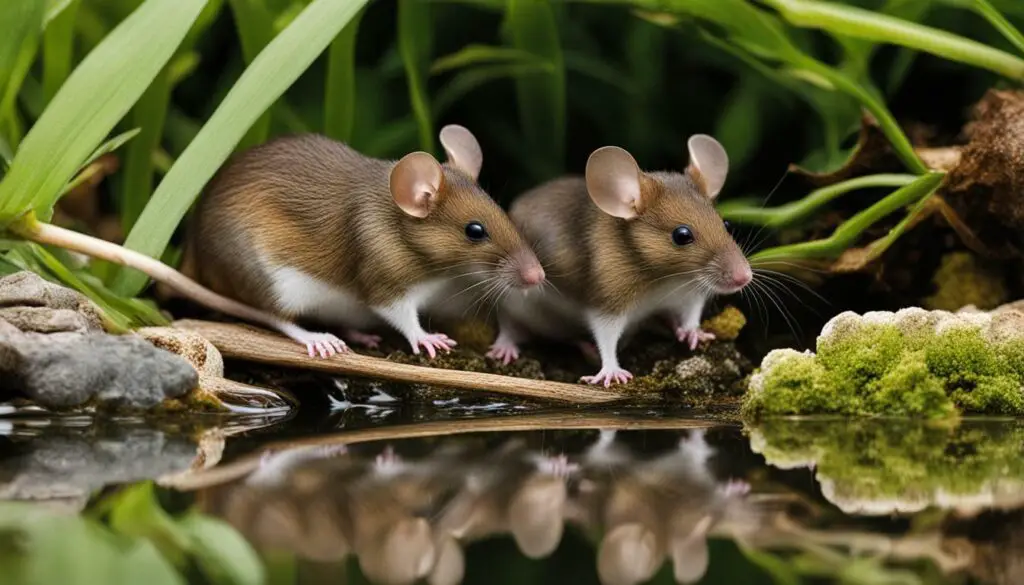
Explore the effectiveness of pool fences and barriers in keeping mice away from water sources. When it comes to preventing mice from accessing pools and other water sources, physical barriers play a crucial role. By installing pool fences or barriers, you create a deterrent that can help protect your pool area from unwanted rodent visitors.
Mice are naturally curious creatures, and their ability to swim makes them more likely to explore areas with water. However, by implementing proper fencing, you can significantly reduce the risk of mice entering your pool.
There are various types of pool fences and barriers available, each with its own advantages. One popular option is mesh pool fencing, which provides a transparent yet sturdy barrier that prevents mice from entering the pool area. Another option is solid metal or plastic fencing, which creates a more solid boundary that mice cannot easily penetrate. Whichever style you choose, make sure the fence is designed to extend below ground level to prevent mice from burrowing underneath.
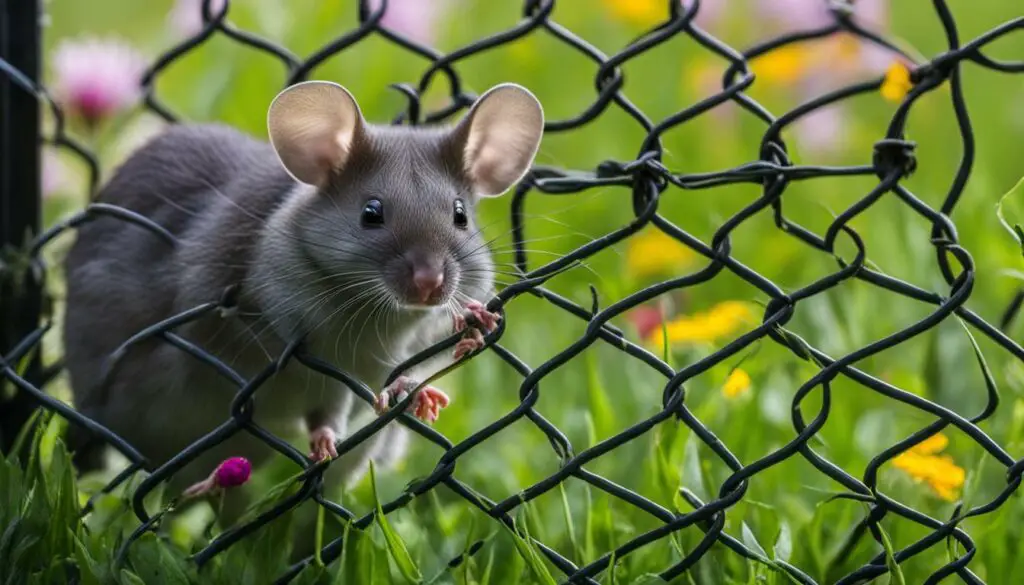
In addition to pool fences, you can enhance mouse control by incorporating other deterrents. Keep the area around the pool clean and free of debris, as mice are attracted to food sources. Landscaping should be maintained to remove potential hiding places for mice, such as overgrown bushes or tall grass. Using scent discs or mouse baffles can also be effective in deterring mice, as they emit odors that mice find unpleasant.
By combining pool fences or barriers with these additional measures, you can create a mouse-free zone around your pool. Take proactive steps to ensure that mice are discouraged from entering the pool area, protecting both the rodents and your swimming environment.
| Pool Fences and Barriers | Advantages |
|---|---|
| Mesh pool fencing | Transparent, sturdy barrier |
| Solid metal or plastic fencing | Creates solid boundary |
| Extended below ground level | Prevents burrowing |
Conclusion
In conclusion, mice have the ability to swim in water, although it is not their preferred method of travel. Factual data shows that mice can swim and tread water for up to three days, and they can hold their breath underwater for up to three minutes. However, swimming exposes mice to potential dangers as they become vulnerable to predators.
While mice can swim, they generally avoid water if given the option, choosing dry land instead. This behavior is likely due to the risks associated with being in aquatic environments. Swimming puts mice in a position where they are more exposed and less agile, making them an easy target for predators.
If you want to prevent mice from entering pools and water sources, there are several effective strategies you can implement. Keeping the pool area clean and free of debris is essential, as mice are attracted to food and shelter. Maintaining landscaping around the pool can also help remove potential hiding places for mice, making the area less appealing to them.
Additionally, you can use scent discs or mouse baffles as deterrents, as these can help repel mice and discourage them from approaching the pool. Installing pool fences or barriers is another effective measure to keep mice away from water sources, creating a physical barrier that prevents their access.
By implementing these strategies, you can create an environment that is less attractive to mice and reduce the chances of them entering pools or water sources. Remember, while mice have the ability to swim, it is best to discourage their presence in water-rich areas to ensure their safety and minimize any potential damage or inconvenience they may cause.
FAQ
Can mice swim in water?
Yes, mice are capable of swimming. While it is not their preferred form of travel, they have the ability to swim and tread water for up to three days. However, mice do not typically enjoy swimming and will choose dry land over water if given the option.
What are the swimming abilities of mice?
Mice can swim and hold their breath underwater for up to three minutes. They have the ability to navigate in water, although swimming puts them in a vulnerable position, making them exposed to predators.
Do mice float in water?
Yes, mice have natural buoyancy and are capable of floating in water. However, floating is not their natural behavior and they will usually opt to swim or find dry land if possible.
What are the risks of drowning for mice?
Mice are at risk of drowning when they are in water, especially if they are unable to find an escape route. Their vulnerability in water makes them prone to drowning, so it is important to ensure their safety if they become trapped.
How do mice behave in water-rich environments?
Mice are adaptable creatures and have certain behaviors and adaptations for surviving in water-rich environments. They may utilize their swimming abilities to find food or shelter, but they generally prefer to stay on dry land.
How can I prevent mice from entering pools?
To deter mice from entering pools, it is important to keep the pool area clean and free of debris. Removing potential hiding places in the surrounding landscaping and using scent discs or mouse baffles can also help discourage mice from approaching the pool.
What landscaping techniques and mouse deterrents can I use?
Modifying the landscaping around the pool area can deter mice by removing potential hiding spots and access points. Additionally, using mouse deterrents such as scent discs or mouse baffles can help keep mice away from water sources.
Can pool fences and barriers help with mouse control?
Yes, installing pool fences or barriers can be an effective way to prevent mice from accessing pools and water sources. Physical barriers create obstacles for mice and make it harder for them to enter the area.
Conclusion
In conclusion, mice can swim in water, although it is not their preferred form of travel. They have the ability to survive in water for a limited time, but swimming puts them at risk of predation. Taking preventive measures such as maintaining a clean pool area, modifying the surroundings, and using physical barriers can help keep mice away from pools and water sources.

